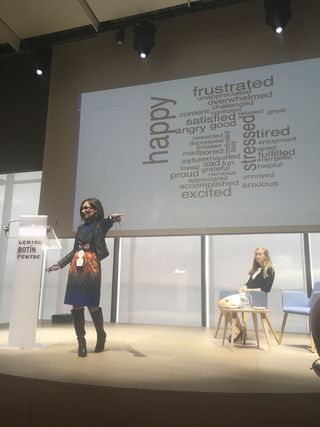Creativity
Creativity Runs on Passion
How the joy and stress of passion fuels creativity and innovation.
Posted October 21, 2019 Reviewed by Lybi Ma
Scholars studying the role of emotions in creativity and innovation gathered last week at the Centro Botin in Santander, Spain to send a message that creativity is not just about thinking, but centrally involves emotions. Emotions inspire and fuel creativity, such as when an artist depicts the peace they experienced on a quiet winter day, when a scientist is annoyed by an inconsistency in research findings, or when an entrepreneur is driven by the frustration of shopping to create a grocery delivery company. Crucially, there isn’t one emotion uniquely beneficial for creativity. The secret is in how we use the pleasant and unpleasant experiences towards creativity.

The Role of Emotions in Creativity
Traditional research on creativity and emotion used brief experimental studies. People would be brought into the lab, a mood created (e.g., by listening to music), and they would be given a three-minute creative thinking task, such as coming up with ideas for different ways to use a brick. Reliably, this research showed that happy, pleasant and energized moods, were beneficial for creative thinking.
The problem is that creativity is more than coming up with ideas in short bursts, in response to problems someone else developed, and in relation to problems for which a person does not have an interest. Real-life creativity is the opposite; creators are passionate about their work, they spend a lot of time on it, and they devise problems and find opportunities for creation themselves. If we are interested in creativity in the real world, we need to learn about it from real-life relevant research.
The challenge of creativity is that of finding opportunities, something that can be transformed, coming up with ideas for possible creations, and transforming ideas into products. As the conference took place in Spain, an apt example is the use of grapes. We could have ideas that grapes can be turned into wine, vinegar, raisins, or preserves. But having these ideas is different from creating wine, vinegar, raisins, or preserves. The idea of a creative wine is not the same as bringing it into existence. Much creativity happens during the process of actualizing ideas. How would the wine be created? Would it be a blend of grapes (and which ones)? How would it be aged? The list of factors affecting the creativity of the product (flavor of wine) is long and complex.
The distinction between creative ideas and creative work transforming ideas into products (inventions, performances) stresses the range of emotions in the creative process. I recently conducted a study of artists—painters, sculptors, choreographers, composers, writers—about emotions in their creative process. The dominant emotions they described as inspiration for their work were pleasant, such as love, happiness, and joy. But they also mentioned sadness, which is an unpleasant emotion, as well as nostalgia, which emotion scholars consider a mixed emotion, made up of fondness and melancholy.
In contrast, when describing emotions during the day-to-day work of creating and transforming ideas into products, whether short stories, paintings, or choreographies, the artists most prominently mentioned frustration. By definition, creativity is hard. There are obstacles when doing something original. And negative reviews. All of this is integral to creativity.
Of course, creativity does not exist just in the arts. What about emotions in work more generally? In a study of close to 15,000 people across all industries in the U.S., we compared people who are not creative at work and those who are highly creative at work. Those who are not creative predominantly mentioned feeling stressed, tired, bored, angry, and overwhelmed at work. When unpleasant emotions turn into full-blown burnout and dread, creativity indeed suffers. Those who are highly creative mentioned being happy, but frustration and stress were also prominent.
Passion Fuels Creativity
A key emotional resource for creative work is passion. We tend to think of passion as positive, pleasant, and energized, but it is actually more complex. Dr. Julia Moeller (University of Leipzig, Germany) reviewed models of passion across personality, social, developmental, and sports psychology and identified four major components.
First, passion involves a strong desire, a pressing urge, for an activity (e.g., studying creativity). Also, it includes having goals related to the activity (e.g., I will continue studying creativity and write about it in the future), building an identity around the activity (e.g., I do not just study creativity, I am a creativity scientist), and perseverance in the face of obstacles (e.g., I will keep trying to publish my work, even after rejections).
Individuals passionate for their work—whether they are scientists, poets, entrepreneurs, operations managers or something else—are able to use the energy afforded by their passion as a motivator of their work. It is not the case that they will be always happy or satisfied, but their desire and commitment will enable them to have a long-term view of work that ultimately makes it possible to work through the stress and frustration and keep the long-term goals in mind.
Highly passionate individuals describe a lot of positive emotions at work; they feel interested, confident, proud, and happy. But they are no strangers to feelings of frustration, tension, and stress either. Some level of stress comes with passion and creative work. Passion, with all its emotional intensity and complexity, predicts creativity and innovation at work beyond the overall experience of positive emotions, job satisfaction, and engagement.
What Do We Need to Know About Emotions and Creativity?
As scholars, we might have been asking the wrong question. Instead of what emotions benefit creativity, we need to understand how we use and manage the diverse feelings we have. We could use unpleasant emotions to inform constructive feedback or tap into emotional memories to evaluate (and reevaluate) what we are creating.
In particular, managing emotions—using personal strategies and social support—helps us to maintain effort, persist in the face of obstacles, and sustain passion for work. In turn, this enables us to complete the transformation of ideas into products (or performances or inventions). Personal strategies can include taking a break from the work to get some distance, reappraising situations and finding silver linings or lessons in challenges we face, adapting our goals or changing our approach, and many others.
Importantly, the success of how we manage emotions will not only depend on our own abilities or actions, but also on those around us. If you are not acknowledged or, worse, if you are actively disrespected, it is not enough to be competent. Individual creativity and innovation will depend also on emotional competencies of our supervisors and leaders—whether they notice people who are dissatisfied at work, the extent to which they help employees channel that dissatisfaction into creating effective change, the extent to which they understand and are interested in how their decisions affect others, and their support to employees to manage difficult emotions at work.
LinkedIn Image Credit: ESB Basic/Shutterstock
References
Ivcevic, Z., & Brackett, M. (2015). Predicting creativity: Interactive effects of Openness to Experience and Emotion Regulation Ability. Psychology of Aesthetics, Creativity and the Arts, 9, 480-487. http://dx.doi.org/10.1037/a0039826
Ivcevic, Z., & Hoffmann, J. D. (2019). Emotions and creativity: From process to person and product. In J. C. Kaufman & R. S. Sternberg (Eds.). Cambridge Handbook of Creativity (pp. 273-295). New York: Cambridge University Press.
Moeller, J., Ivcevic, Z., White, A. E., Taylor, C., Menges, J. I., Caruso, D., & Brackett, M. A. (2019). Passion for work: What is it, who has it, and does it matter? Preprint. https://doi.org/10.31219/osf.io/xhbu7




